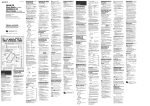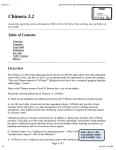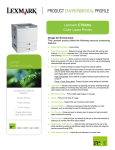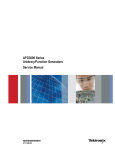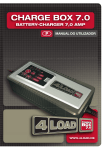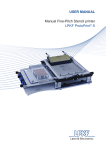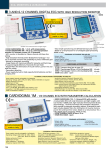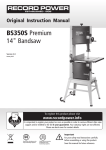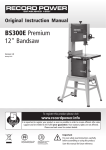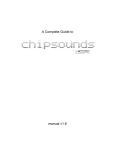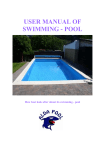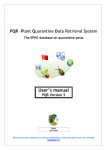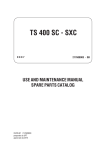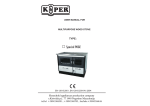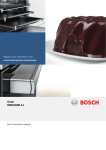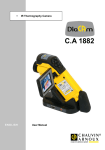Download Guidelines On Environmental Labeling Requirements
Transcript
Design Guideline Standard G3810 Standards Engineering Issued Revised Revision Page NOV 02 JAN 06 F 1 of 33 This document/data record is the property of Pitney Bowes Inc. and contains PROPRIETARY and CONFIDENTIAL information, and is not to be copied. Pitney Bowes Guideline on Environmental Labeling Requirements I. INTRODUCTION Electronics products, batteries, and packaging are all subject to a variety of often conflicting domestic and international labeling requirements. Each type of requirement may affect the labeling and artwork considerations for each of these areas. For example, a battery law may require battery information to appear on the battery, the product, the package, and/or the owner’s manual. This guide is intended to aid PB personnel, its OEMs, and suppliers in seeing through the maze of overlapping requirements and in selecting and using labeling in conformant with applicable laws, regulations and guidelines. The Overview table illustrates how each type of regulation may affect the product at different different levels (e.g. component, whole product, battery, package). The document is cross-linked to facilitate use by different PB staff, OEMs, and suppliers. To find all of the labeling that must be included in the artwork for the packaging, one may read down the column for packaging labeling. On the other hand, a manager overseeing membership in a collection program for batteries may wish to ensure that the collection program’s logo appears in all the right places. To navigate the document, start with the Overview and click on a heading or a bulleted item to view the requirements in detail. At the end of the document you will find a Glossary and a list of other PB Documents that relate to product and packaging design, batteries, and other relevant topics. Design Guideline Standard G3810 Standards Engineering Issued Revised Revision Page NOV 02 JAN 06 F 2 of 33 This document/data record is the property of Pitney Bowes Inc. and contains PROPRIETARY and CONFIDENTIAL information, and is not to be copied. II. OVERVIEW TABLE OF LABELING REQUIREMENTS Click on any item to link to section headings. Type of Requirement III. Packaging Labeling Requirements Requires labeling on: Packaging Mandatory Labeling Batteries Products Other Information / Owner’s Manual n/a n/a Invoicing All Batteries All Batteries Pre-Installed Batteries Pre-Installed Batteries KCA Logo Take-back symbols Batteries that Contain Heavy Metals KCA Logo PB Name & Logo Mercury Four-Arrow Symbol Batteries that Contain Heavy Metals Taiwanese Labeling Non-removable Batteries Recycling/Disposal Info Symbols and Labeling as on Battery Non-removable Batteries Material Coding Take-back symbols Recycling / Disposal Symbols Wood packaging Voluntary Labeling Material Coding Recycled content Claims language Take-back symbols IV. Battery Labeling Requirements Wheelie Bins Chemical Composition Recycling/Disposal Info Recycling/Disposal Info Chemical Composition Recycling/Disposal Info Wheelie-bin KCA Logo Take-back symbols V. Product/ Electronics Labeling Requirements Required Labeling RoHS Labeling WEEE Labeling Mercury-Containing Assemblies Isotiazolines Packaging made from Expanded Resins n/a Required Labeling RoHS Labeling WEEE Labeling Mercury-Containing Assemblies Isotiazolines Coding of Major Components Video Displays Required Information WEEE Labeling Recycling/Disposal Info Recommended Information EU Recycling/Disposal Info Video Displays 2 Design Guideline Standard G3810 Standards Engineering Issued Revised Revision Page NOV 02 JAN 06 F 3 of 33 This document/data record is the property of Pitney Bowes Inc. and contains PROPRIETARY and CONFIDENTIAL information, and is not to be copied. Wheelie-bin Recommended Labeling Mexican SPI coding Wheelie-bin III. PACKAGING LAWS - REQUIREMENTS IN DETAIL IIIA Mandatory Labeling of Packaging IIIA–1 Material Coding Austria Material coding is mandatory on plastic packaging in Austria. This requirement can be satisfied by use of the SPI code (see below). Exempted from this requirement are dangerous goods, drugs, sterile medical, skin packs, gift packs, unprinted films, bags, films with area less than 0.125 m2 or rigid packaging with a volume <100ml. Croatia A 1996 decree requires marking of plastic packaging and composite packaging with both a number and an abbreviation. The markings specified differ from both the voluntary EU identification system and the U.S. SPI coding system. The identifying number codes are the same as the SPI codes, but the abbreviations are as follows: 01=PET 02=PE-HD 03=PVC 04=PE-LD 05=PP 06=PS 07=Other Czech Republic Since 1999, material marking has been required on packaging. Symbology closely follows the EU material coding system. Industrial standard CSN 770052-2 recommends the use of a triangle plus numeric code in it or a triangle plus an abbreviation below it, or a triangle plus both numeric code and abbreviation. The producer may decide to use a different form of simple, easy to understand, marking, but is advised to follow the industrial standard to avoid any possible problems with government authorities. The Trade Inspection and Environment Inspection do check marking and consumer disposal information. They are entitled to impose a fine of up to CZK 500, 000 in each individual case of improper material marking and up to CZK 500, 000 in each case where the information on package disposal is not attached to product. Czech Standard ČSN 77 0052-2 has been revised, making material coding mandatory for plastics, metals and composites. Material coding is voluntary for paper, glass, wood and textiles. Exemptions to identification marking: 3 Design Guideline Standard G3810 Standards Engineering Issued Revised Revision Page NOV 02 JAN 06 F 4 of 33 This document/data record is the property of Pitney Bowes Inc. and contains PROPRIETARY and CONFIDENTIAL information, and is not to be copied. - packages made from shrink foil or extruded plastic foil, unless printed on and labeled; - packages whose nominal volume is 50 ml or less; - inner fixing elements, interlayer and inserts, unless marked by printing, embossing and/or stamping; - dosing and charging devices, applicators; - closures, caps, lids, stopgaps; - labels, stickers, tags; - packaging components whose weight is 5 grams or less. Latvia Latvia requires material marking based on the EU material coding system (see Section IIIB-1). Additionally, indication of the percentage of recycled content (if used) is mandatory on metal and plastic packaging as of 2 April 2002 and on packaging made of glass, paper, paperboard, wood, textiles and composite materials as of 1 January 2004. Lithuania The packaging law requires material coding, but the specific procedure will be determined by a subsequent regulation. Poland Polish regulations require producers to mark aluminum and plastic packaging according to material content and recyclability. The following exemptions apply: 1) aluminum foil covered by plastics and laminates with aluminum foil, paper, or cardboard paper; 2) two or more different materials, but such packaging shall not be considered to be made of one type of the material with a closing made of another material; 3) aluminum of a mass less than 5 grams. SPI and other US, or EU coding (see Section IIIB-1) may be used. Romania Romania requires material coding using a system similar to the EU coding system. Details TBD. Slovakia Slovakia requires material coding following the EU coding system (see Section IIIB-1) and the use of the Tidyman symbol (right). Effective January 1, 2006, only packaging or packaged products which are marked (material coding, disposal mark) may be placed on the market. Multi-trip packaging must be clearly and legibly marked with the words Návratny obal (returnable packaging). Exemptions from marking: Packs with a surface of less than 100 cm2; packs with a capacity that does not exceed 50 ml; inner fixings, components and inner layers if these are not printed or embossed; plastic film that is not printed or that bears no label; packaging ancillaries such as labels or hang tags; and packaging components whose weight does not exceed 5 g. Marking details: 4 Design Guideline Standard G3810 Standards Engineering Issued Revised Revision Page NOV 02 JAN 06 F 5 of 33 This document/data record is the property of Pitney Bowes Inc. and contains PROPRIETARY and CONFIDENTIAL information, and is not to be copied. Marking must be placed such that it will not be damaged or removed when the pack is opened or during use. However, if it is not possible to mark the pack itself "for technical reasons", then the marking can be placed inside the pack or, if the properties of the product do not permit this, on a separate leaflet handed over together with the packaged product. South Korea Material coding is required; South Korean system uses material-specific logos with a separate disposal message – see Section IIIA-3, Recycling / Disposal Symbols. The use of the SPI coding system is not required. Japan Material identification marks are now mandatory on paper and plastic containers and packaging in addition to steel and aluminum containers, and PET bottles. Note that this labeling is required only on packaging of products sold to consumers (households). The Ministry of International Trade and Industry has issued new guidelines for the material marking to be placed on the packaging of products sold in Japan. The SPI code is allowed on PET bottles, but should be conspicuous (unlike under the FTC guidelines). (Use of the SPI code according to standard use guidelines is permitted but not required.) Japanese Material Coding System The guidelines for complying with the Japanese material labeling requirements indicate the following major points: 1. The obligation to place the material identification marks on paper and plastic began on April 1, 2001. Penalties will not be applied before March 31, 2003, but businesses are expected to comply soon in order to promote the selective collection of packaging waste. 2. The vertical size of the marks shall be 6mm or more for printing and 8mm or more for embossing. 3. If the labeling would require printing on a package that would not otherwise undergo a printing process, the package is exempt from the requirements. Packages that are too small (less than 50 square cm), or whose shape would make affixing the label impossible, are also exempt. However if any of these packaging components are part of a packaging system (e.g. outer film with no labeling around other printed components, small cap on bottle with labels), the exemptions do not apply. Either each component must be labeled or: • For packaging that is either too small or of an odd shape (as mentioned above) the identification mark shall be placed on 5 Japanese Material Coding of multiple components on same label Design Guideline Standard G3810 Standards Engineering Issued Revised Revision Page NOV 02 JAN 06 F 6 of 33 This document/data record is the property of Pitney Bowes Inc. and contains PROPRIETARY and CONFIDENTIAL information, and is not to be copied. another packaging component in addition to its own mark. • Marks for two or more packaging components may be placed on either component if they are to be discarded at the same time. 4. Wrapping paper (paper or plastic) used in department stores is subject to marking requirements if the company name is printed on it. A sheet 1,300 cm2 or less is exempted. However, it is preferable to add the mark even on a small piece if the cutting shape is known when the paper is ordered. Turkey All packaging must be marked with the appropriate EU material code and the Möbius loop. Companies who recover their own waste must label packaging with a Ministry-assigned code. The regulation requires that all companies who are part of a recovery system must label packaging with the relevant symbol of the organization (e.g. Green Dot). SPI Coding The use of Society of the Plastics Industry (SPI) codes is required in 39 states of the US and is used (although not required) in many other Latin American countries on all plastic containers 8 oz. and greater (200 ml in metric countries). Mexico encourages, but does not require, use of a coding system based on the SPI code*. In Taiwan, the SPI code is required on containers that are subject to recycling fees. SPI Resin Codes MATERIAL Polyethylene Terephthalate High Density Polyethylene Polyvinyl Chloride Low Density Polyethylene Polypropylene Polystyrene Other MAT. NO. 1 2 3 4 5 6 7 ABBREVIATION PETE HDPE V LDPE PP PS OTHER The symbol should be molded or embossed into the base of the container. The recommended size is between one-half inch and one inch, depending on the size of the container (measurements are for the symbol alone, not including letters). The SPI code is only a resin identification code to aid in plastics sorting. It is not a recycling or environmental symbol and may not be placed prominently on the container or label. The use of the SPI code is subject to FTC guidelines (see Section IIIB-3). For FTC rulings on deceptive use of the SPI code, refer to the FTC Guidelines. *Note: Mexico follows a coding system very similar to the SPI coding discussed above. There are significant differences, however, between the SPI system and the Mexican coding system. These differences are as follows: 6 Design Guideline Standard G3810 Standards Engineering Issued Revised Revision Page NOV 02 JAN 06 F 7 of 33 This document/data record is the property of Pitney Bowes Inc. and contains PROPRIETARY and CONFIDENTIAL information, and is not to be copied. IIIA-2 • In Mexico, there are no size exception allowances such as the small package size exemption (e.g. under 8 oz.) or maximum size cutoffs (e.g. excluding over 5 gallons) • Mexico applies the coding system to all products made of plastic (of resin types 1-6), not just plastic containers as in the U.S. • Mexico allows placement of the code anywhere that is legible, while the U.S. restricts the code to the bottom of the container • Mexico’s coding system follows the 1 through 6 designations for certain resin types, but does not use the designation #7 (Other) that the U.S. system allows. Take-Back Symbols Green Dot The Green Dot is required in France, Germany, Portugal, and Spain. The Green Dot is the symbol of Packaging Recovery Organisation Europe s.p.r.l., or PRO ® EUROPE. The Green Dot does not make an environmental or recycling claim; it is an indication that the manufacturer has paid membership fees to a PRO EUROPE organization. Use of the Green Dot trademark in any of the countries listed in this section requires a valid membership agreement with a Green Dot licensing or recovery organization. Status of Green Dot by Country Mandatory (as part of Recovery Scheme) France Germany Portugal Spain Turkey Voluntary (as part of Recovery Scheme) Austria Belgium Czech Republic Estonia Greece Hungary Ireland Latvia Lithuania Luxembourg Norway Poland Slovakia Slovenia Sweden Requires Licensing Only Canada UK The Green Dot must be easy to locate and identify and may bear no additional text, graphics, or similar modifications. Note: the words “Der Grüne Punkt” are not required to appear above the symbol; in fact, their use is discouraged in many countries. The orientation must be as in the illustration (above), with the darker arrow pointing upwards to the right and the lighter arrow pointing downward to the left. The standard colors are Pantone 343 C (dark green) and Pantone 366 C (light green). Alternatively, the logo may appear in one color on a white background, or in white on a color background, as long as the color corresponds to the dark green and the white 7 Design Guideline Standard G3810 Standards Engineering Issued Revised Revision Page NOV 02 JAN 06 F 8 of 33 This document/data record is the property of Pitney Bowes Inc. and contains PROPRIETARY and CONFIDENTIAL information, and is not to be copied. corresponds to the light green. The recommended size is 10 mm, but 6 mm is acceptable for extremely small packages. The logo may be printed, checked, stamped or embossed. The artwork files and a detailed set of guidelines for the implementation of the mark is included in the membership contract and license for all PRO EUROPE organizations or at http://www.greendot.org.uk/ (select >Joining >Standards of Use). IIIA-3 Recycling / Disposal Information Estonia PVC containers must be marked with "No incineration!” South Korea South Korea passed a new material coding requirement in December 2002 (Ministry of Environment Notification No. 2002-195). Although this labeling requirement is effective January 2003, there is a grace period until December 31, 2003 for companies to comply. Material coding is mandatory on all packaging of certain product types using the symbol below. Product types covered are the following: foods and beverages, agricultural produce, dairy and fishery products, detergents, cosmetics (excluding glass containers), shampoos and conditioners for pets, drugs, butane gas, pesticides. Packaging for the above products are required to bear the “separate disposal” label only if it is composed of a paper pack (limited to paper packs that are coated and pasted with synthetic resins or aluminum foil), metal container, glass container or plastic resin. Electronic equipment “buffers” for all electronic equipment (i.e. consumer and commercial goods) must also be labeled. A "buffer" is defined as any packing materials that are made from foam-like single synthetic resins, which are made of beads containing hydrocarbons such as butane, hexane, pentane, etc., puffed by applying heat, or by other means. Examples of "buffer" materials are expanded polystyrene (EPS), polystyrene paper (PSP), expanded polyethylene (EPE) and expanded polypropylene (EPP). Sealed air is NOT considered a buffer and need not be labeled. There are exemptions to the separate disposal labeling requirement, which include the following: packaging components that bear no labeling, engraving, or printing; packaging materials whose surface is less than 50 square centimeters; packaging components whose volume is less than 30 grams or 30 milliliters; packaging material on which it is impossible to print, engrave, or label due to elements or structural properties. Shopping bags and wrappings filled at point of sale by sellers are exempt from the mandatory recycling, and thus the labeling requirement. (Please note that for buffers that have no printing/engraving, or for which labeling is impossible, the buffer should not be labeled and the label should not be placed on the box in lieu of the buffer.) The Korean text below the triangle reads “separate disposal.” Material type abbreviations (PET, HDPE, LDPE, PP, PS, PVC, OTHER, metal, Fe, Al, paper, paper pack, or glass) should be indicated inside the triangle. Material types, other than plastic resins, should be written in Korean. The symbol (excluding the “separate disposal” text below) must be larger than 8mm in width and length. The height of the “separate disposal” Korean text should be one fourth of the width of the symbol. The extension of each side of the symbol is a regular triangle, whose inside angle is 60° and outside angle at the bended 8 Design Guideline Standard G3810 Standards Engineering Issued Revised Revision Page NOV 02 JAN 06 F 9 of 33 This document/data record is the property of Pitney Bowes Inc. and contains PROPRIETARY and CONFIDENTIAL information, and is not to be copied. part of the arrow’s end is 120°. The color of the mark should be distinct from other colors used on the packaging, so as to make the mark clearly visible. (Note: EPI interprets this as applying only to printed packaging, not embossed symbols.) The label should be located on the front or side flank of the component, unless impossible, in which case the mark could be located on the bottom of the package. If there are multiple components, each component should bear a material label. However, if it is impossible to label each component, or if there is no printing/engraving on a component, then only the major component should be labeled to indicate its material type as well as the material types of the other non-labeled components (referred to as inclusive labeling). Inclusive labeling is prohibited from use on food packaging that, under the Food Sanitation Act, must indicate ingredients on the packaging. Previous material coding regulations were repealed as of December 31, 2002. Producers and/or importers that wish to use this “separate disposal” label on other packaging materials on a voluntary basis must apply for its use through KORECO. Producers and/or importers may also voluntarily label other packaging elements (i.e., packaging elements not required to bear the “Separate Disposal” label) with material identification, empty space ratio and number of layers. Italy Italy no longer requires the use of the phrase “non disperdere nell'ambiente dopo l'uso” (“Do not litter”) or the “Tidyman symbol” on all containers for liquid products. In order to harmonize labeling requirements with those of the EU, the Italian government has repealed the requirement to label containers that contain liquid with the Tidyman symbol or the statement "Non disperdere nell'ambiente dopo l'uso". This labeling requirement was officially repealed as of February 22, 2003. Taiwan Taiwan requires the use of a four-arrow symbol (right) on all containers (either on the container itself, the inner or outer wrapping, or on the packaging label) that are subject to recycling under the Waste Act. At present, this requirement does not apply to PB products. In addition to the four-arrow symbol, plastic containers should also have a material symbol (SPI codes are suitable). IIIA-4 Marking of Wooden Packaging Restrictions exist on wood packaging material (including coniferous and non-coniferous wood, in manufactured and non-manufactured form) transported internationally in several countries (e.g. US, EU and Member States, Australia, China, Brazil, Argentina). In general, these restrictions apply to wood packing in the form of: packing cases, crates, drums, pallets, box pallets, or other load boards, dunnage, spacers, and bearers including those which have not kept their natural round surface. These restrictions do not cover wood shavings and sawdust. The internationally agreed wood treatment mark (right) must be placed on wood that has been treated. The letters in parentheses are used here to indicate the meanings of each element of the mark: 9 Design Guideline Standard G3810 Standards Engineering Issued Revised Revision Page NOV 02 JAN 06 F 10 of 33 This document/data record is the property of Pitney Bowes Inc. and contains PROPRIETARY and CONFIDENTIAL information, and is not to be copied. (a) Trademark – the identifying symbol, logo, or name of the accredited agency (optional) (b) Mill Identification – product manufacturer name, brand or assigned mill number (the unique number assigned by the national plant protection organization to the producer of wood packing who is responsible for ensuring the appropriate wood is used and properly labeled) (c) Heat Treated mark (the abbreviation indicating treatment, i.e., heat treatment, HT; methyl bromide fumigation, MB; de-barking DB; chemical pressure impregnation, CPI) (d) Country Code – the two letter ISO country abbreviation For pallets manufactured of 100% manufactured wood, a Manufactured Wood Certification Stamp must be used. Manufactured wood includes oriented strandboard, plywood, strawboard, masonite, particle board, paper overlaid veneer, laminated veneer lumber or any combination of these. To the right is an example of Manufactured Wood Certification Stamp to be used on manufactured wood pallets. The letters in parentheses are used here to indicate the meanings of each element of the mark: (x) (y) US – 000 MWPM (z) (x) Country Code – the two letter ISO country abbreviation (y) Mill Identification – product manufacturer name, brand or assigned mill number (z) Approved International symbol for compliant non-manufactured wood packing These labels should be marked legibly, visibly and on two opposite sides of the wood article. The mark should not be made in the colors orange or red, which are colors used to label packaging containing dangerous goods. On March 18, 2002 the Interim Commission on Phytosanitary Measures (ICPM), mandated by the IPPC (The International Plant Protection Convention, to which 117 countries are party) adopted an international wood packaging mark (similar to that shown above) but which included a “no bug” symbol. As of June 2002, the IPPC suspended the use of the international wood packing "no bug" symbol, due to difficulties in protecting the symbol. In May 2003, a new certification mark was published and incorporated into the International Standard for Phytosanitary Measures: Guidelines for regulating wood packaging in international trade (ISPM No.15). The mark is available for use by IPPC Contracting Parties and members of FAO, through the National Plant Protection Organizations (NPPOs). See symbol below. 10 Design Guideline Standard G3810 Standards Engineering Issued Revised Revision Page NOV 02 JAN 06 F 11 of 33 This document/data record is the property of Pitney Bowes Inc. and contains PROPRIETARY and CONFIDENTIAL information, and is not to be copied. The mark should at minimum include the: • • • IIIB symbol ISO two letter country code followed by a unique number assigned by the NPPO to the producer of the wood packaging material, who is responsible for ensuring appropriate wood is used and properly marked IPPC abbreviation according to Annex I for the approved measure used (e.g. HT, MB). Voluntary Labeling and Environmental Claims IIIB-1 Material Coding EU Material Coding Background and application: The Packaging Directive called for the development of an EU material coding system. Although the 1994 Directive foresees a mandatory marking system, the system created is explicitly voluntary. However, it provides for the possibility that material coding could be made mandatory by a future decision. Although material coding in Europe is voluntary at the EU level, several of the new member states have laws requiring material coding of packaging using the EU coding system (see Section IIIA-1 on Mandatory material coding). It should be noted that they may be required to adapt their laws to make the material coding voluntary, but in the meantime, the marking requirements are in effect. In Estonia and Germany, material coding is voluntary, but if applied, it must be consistent with the EU coding system. It may also be used to satisfy material identification requirements that do not specify a particular system (e.g. Austria, Czech Republic, Poland). Guidelines for use: The 1994 Directive, in describing the system to be developed, states that “[p]ackaging shall bear the appropriate marking either on the packaging itself or on the label. It shall be clearly visible and easily legible. The marking shall be appropriately durable and lasting, including when the packaging is opened.” The Directive also states that “[m]aterials may be identified by a numbering system and/or abbreviation. The identification marks shall appear in the centre of or below the graphical marking indicating the reusable or recoverable nature of the packaging.” These details regarding the application of the system are not included in the Decision establishing the system itself, which contains only the numbers and abbreviations, but not logos. The abbreviations must appear in all capital letters (except for the abbreviations for steel and aluminum). EPI recommendations: • Use EU material coding where possible 11 Design Guideline Standard G3810 Standards Engineering Issued Revised Revision Page NOV 02 JAN 06 F 12 of 33 This document/data record is the property of Pitney Bowes Inc. and contains PROPRIETARY and CONFIDENTIAL information, and is not to be copied. • Use the codes without the round Möbius loop, three-chasing-arrows or other logo to avoid conflicts with Czech law and any appearance of an environmental claim. (It may be advantageous, however, to use the three-chasing-arrows symbol with plastic codes when this can be done in a manner that is consistent with SPI and FTC Guidelines, enabling you to meet both requirements with one symbol.) • For composites not assigned a number, use the appropriate abbreviation according to the predominant material, and omit a numerical code • For material types not listed at all, do not label unless required by a national law (in that case, use the applicable code from that country’s system) EU Material Coding System Material Abbreviation Number Polyethylene Terephthalate PET 1 High Density Polyethylene HDPE 2 Polyvinyl Chloride PVC 3 Low Density Polyethylene LDPE 4 Polypropylene PP 5 Polystyrene PS 6 Corrugated fibreboard PAP 20 Non-corrugated fibreboard PAP 21 Paper PAP 22 Steel FE 40 Aluminum ALU 41 Wood FOR 50 Cork FOR 51 Cotton TEX 60 Jute TEX 61 Glass clear GL 70 Glass green GL 71 Glass brown GL 72 Paper and cardboard/miscellaneous metals * 80 Paper and cardboard/plastic 81 12 Design Guideline Standard G3810 Standards Engineering Issued Revised Revision Page NOV 02 JAN 06 F 13 of 33 This document/data record is the property of Pitney Bowes Inc. and contains PROPRIETARY and CONFIDENTIAL information, and is not to be copied. Paper and cardboard/aluminum 82 Paper and cardboard/tinplate 83 Paper/cardboard/plastic/aluminum 84 Paper and cardboard/plastic/aluminum/tinplate 85 Plastic/aluminum 90 Plastic/tinplate 91 Plastic/miscellaneous metals 92 Glass/plastic 95 Glass/aluminum 96 Glass/tinplate 97 Glass/miscellaneous metals 98 *for composites, the material abbreviation is “C/“ plus the abbreviation for the predominant material, e.g. C/PAP for composite that is predominantly paper Specifications: The directive states merely “[p]ackaging shall bear the appropriate marking either on the packaging itself or on the label. It shall be clearly visible and easily legible. The marking shall be appropriately durable and lasting, including when the packaging is opened.” The abbreviations must appear in capital letters. IIIB-2 Recycled Content Claims regarding the use of recycled content should be made with caution. General and unqualified claims such as “made from recycled materials” or “made using recycled materials” should be avoided because 1) they do not indicate whether the product or the package has been made using recycled materials, 2) they do not give the percentage of recycled materials used, and 3) they do not specify whether pre- or post-consumer materials have been used. Such claims are considered to be deceptive. (Please refer to Section V, Glossary, for definitions of pre-and post-consumer recycled content.) Claims regarding recycled content should differentiate between product and packaging and must specify percentages of post-consumer and preconsumer content. IIIB-3 Federal Trade Commission Guidelines for Environmental Claims The US Federal Trade Commission guidelines (available at http://www.ftc.gov/bcp/grnrule/guides980427.htm) are the most comprehensive and are comparable to those of other countries. There are also guidelines for the use of Environmental Labeling in the UK and Canada. Claims compliant with FTC guidelines will generally satisfy other guidelines. Environmental labeling that fails to meet these guidelines is considered deceptive. For the full text of other guidelines, refer to “Principles & Guidelines for Environmental Labeling and Marketing” by Consumer & Corporate Affairs Canada (1993) and the UK Department of Environment’s “Green Claims Code of Practice (revised June 2000).” 13 Design Guideline Standard G3810 Standards Engineering Issued Revised Revision Page NOV 02 JAN 06 F 14 of 33 This document/data record is the property of Pitney Bowes Inc. and contains PROPRIETARY and CONFIDENTIAL information, and is not to be copied. General Environmental Claims With regard to brand names, product claims, logos and advertisement, the Federal Trade Commission (FTC) states: “It is deceptive to misrepresent, directly or by implication, that a product, package or service offers a general environmental benefit. Unqualified general claims of environmental benefit are difficult to interpret, and depending on their context, may convey a wide range of meanings to consumers. In many cases, such claims may convey that the product, package or service has specific and far-reaching environmental benefits. As explained in the Commission’s Advertising Substantiation Statement, every express and material implied claim that the general assertion conveys to reasonable consumers about an objective quality, feature or attribute of a product or service must be substantiated. Unless this substantiation duty can be met, broad environmental claims should either be avoided or qualified, as necessary, to prevent deception about the specific nature of the environmental benefit being asserted.” Recyclability Unqualified claims of recyclability for a product or package may be made if the entire product or package, excluding minor incidental components, is recyclable. For products or packages that are made of both recyclable and non-recyclable components, the recyclable claim should be adequately qualified to avoid consumer deception about which portions or components of the product or package are recyclable. Claims of recyclability should be qualified to the extent necessary to avoid consumer deception about any limited availability of recycling programs and collection sites. If an incidental component significantly limits the ability to recycle a product or package, a claim of recyclability would be deceptive. A product or package that is made from recyclable material, but, because of its shape, size or some other attribute, is not accepted in recycling programs for such material, should not be marketed as recyclable. Background: The FTC has amended its guidance for the use of recyclability claims. The guidance from the Federal Trade Commission on the use of recyclable claims is based on the availability of recycling facilities for the package or product. The most significant change made was that the old guidance allowed the use of the phrase "Check to see if recycling facilities exist in your area" as a Safe Harbor Recyclable Disclosure for packaging that is recyclable in a significant percentage, but not a substantial majority of communities (the so-called “second tier”). The new guide removes this “Safe Harbor”. The Commission also concludes that the alternatives suggested by some reviewers, such as "recyclable where facilities exist" would be inadequate to change consumer perception. Example 4 of the Recyclable guide (where this issue is presented) has been revised to suggest the following types of disclosures: "Recycling programs for this bottle [product or packaging] may not exist in your area" or "This bottle [product or packaging] may not be recyclable in your area." Because the new “safe harbors” are tied to the marketed product as opposed to recycling programs generally, they reduce the possibility that consumers may infer that because a recycling program exists in their area, that any product represented as "recyclable" can, in fact, be recycled in their local program". IIIB-4 Take-back Symbols Green Dot ® 14 Design Guideline Standard G3810 Standards Engineering Issued Revised Revision Page NOV 02 JAN 06 F 15 of 33 This document/data record is the property of Pitney Bowes Inc. and contains PROPRIETARY and CONFIDENTIAL information, and is not to be copied. The Green Dot symbol is voluntary in Austria, Belgium, The Czech Republic, Estonia, Hungary, Ireland, Latvia, Luxembourg, Norway, Poland, Slovakia, Slovenia, Sweden, and Turkey. It is permitted in other EU countries. The Green Dot does not make an environmental or recycling claim; it is an indication that the manufacturer has paid membership fees to a PRO EUROPE organization. Use of the Green Dot trademark, including voluntary use, requires a valid membership agreement with a Green Dot licensing or recovery organization. See detailed information on Green Dot in Section IIIA-2 (Mandatory Take-back Symbols). The Czech Republic Packaging that does not carry any particular hazardous characteristics and is treated as standard household waste may be marked to inform the consumer on the proper method of disposal. Industrial standard CSN 770053 covers this type of marking and gives specific symbols or phrases to be used on the packaging itself. The Tidyman symbol (right) may be used. This symbol has the following meaning in the Czech Republic: “Empty packaging should be disposed using municipal waste management programme, in line with the locally applicable municipal decree.” Note: The revised "Tidyman" standard CSN 77 0053 makes the use of the Tidyman symbol voluntary on all non-hazardous packaging; previously, this standard was mandatory. Finland Members of PYR (the Finnish packaging recovery scheme) may print the new PYR logo on their packaging to indicate that they fulfill their producer responsibility obligations via PYR. Portugal Sociedade Ponto Verde recommends labeling consumer packaging with its new “ECOPONTO” icons (Yellow for plastic & metal, Blue for paper/board, Green for glass). The use of these icons is voluntary. Sweden REPA recommends that companies mark plastic, paperboard & metal consumer packaging with sorting symbols and instructions. Companies must be registered with REPA and pay the packaging fees for the specific packaging to be authorized to use the copyrighted pictograms. 15 Design Guideline Standard G3810 Standards Engineering Issued Revised Revision Page NOV 02 JAN 06 F 16 of 33 This document/data record is the property of Pitney Bowes Inc. and contains PROPRIETARY and CONFIDENTIAL information, and is not to be copied. IIIC Other Packaging-Related Information Requirements IIIC-1 Invoicing Italy CONAI, the third-party packaging organization, requires that packaging fees paid appear on the invoice for the packaging and that the subsequent packer/filler and importer invoices mention the fees paid. For PB products imported to Italy, this means that the importer must include the CONAI fees paid on the invoice when he sells the goods to a customer, distributor, retailer, etc. The information can either appear as a separate item on the invoice, a separate column on the invoice, or the fee can simply be included in the price of the product with a statement below the total indicating the amount of fees. Note that if any repacking takes place (this includes overlabeling and repalletizing) you must include the corresponding fees from the invoice received from your supplier on your outgoing invoice. For other members of the distribution chain, format details vary; complete instructions can be found in the current CONAI membership materials. 16 Design Guideline Standard G3810 Standards Engineering Issued Revised Revision Page NOV 02 JAN 06 F 17 of 33 This document/data record is the property of Pitney Bowes Inc. and contains PROPRIETARY and CONFIDENTIAL information, and is not to be copied. IV. BATTERY LABELING REQUIREMENTS IN DETAIL IVA Batteries – Labeling on Packaging IVA-1 All Batteries KCA Logo All batteries (or products containing batteries) sold in the Netherlands must be marked with the KCA logo (an image of a crossed-out garbage container in a frame). For batteries that do not contain heavy metals, it may be printed on either the battery or the packaging. For details on the label and its use, see the full KCA Logo section in Section IVB-1. Crossed-Out Wheelie Bin (for small batteries) Generally, this labeling is required on the battery itself and should cover 3 % of the area of the largest side of the battery or accumulator (for cylindrical-shaped batteries, 3 % of half the surface area of the battery. However, for small batteries, this formula would result in an illegible symbol. In such cases, the symbol measuring 1 × 1 cm must appear on the sales packaging. Be sure to indicate clearly that the symbol refers to the battery, not the packaging or the product. Take-back symbols If PB products include batteries that are recovered in Belgium by the Bebat system, the transport packaging must bear the Bebat label. (For batteries sold separately, the label must appear on the consumer packaging.) IVA-2 Batteries that Contain Heavy Metals Crossed-out Wheelie Bin (for small batteries) Generally, this labeling is required on the battery itself and should cover 3 % of the area of the largest side of the battery or accumulator (for cylindrical-shaped batteries, 3 % of half the surface area of the battery. Where the size of the battery or accumulator is such that the symbol would be smaller than 0.5 × 0.5 cm), the crossed-out wheelie bin symbol measuring 1 × 1 cm shall be printed on the packaging. The chemical symbol must be printed beneath the symbol. It shall cover an area of at least one quarter the size of the crossed-out wheelie bin symbol. However, be sure to indicate clearly that the symbol refers to the battery, not the packaging or the product. Chemical Composition Labeling Taiwan requires the Chinese character symbols to appear on several types of batteries and their packaging. If these batteries are incorporated into a product, label is required on battery, packaging, and electronic product or user manual. For button cells, the labels may be placed on the battery or the packaging. 17 Design Guideline Standard G3810 Standards Engineering Issued Revised Revision Page NOV 02 JAN 06 F 18 of 33 This document/data record is the property of Pitney Bowes Inc. and contains PROPRIETARY and CONFIDENTIAL information, and is not to be copied. Aluminum manganese (button), silver oxide, and mercuric oxide batteries (and/or their packaging) must bear this Chinese character panel (at right). Tubular batteries must bear the symbol on both the cell and the packaging. Also, nickel cadmium batteries and their packaging must be labeled with this Chinese character panel (at right). The labels must cover at least 5% of the battery (or packaging) surface. The minimum dimensions of the label should be 0.5 cm X 0.5 cm. IVB Batteries – Labeling on Batteries IVB-1 All Batteries KCA Logo All batteries (or products containing batteries) sold in the Netherlands must be marked with the small chemical waste, or KCA logo (an image of a crossed-out garbage container in a frame). This label is required for all batteries, but the guidelines for its use vary according to battery type: • For batteries that do not contain heavy metals, it may be printed on either the battery or the packaging. • For batteries containing more than 0.025% of their weight in cadmium or 0.4% of their weight in lead, the logo must be affixed indelibly to the battery and used in association with the chemical symbol (see Section IVB-2). • For built-in batteries, it may be printed on the packaging or the user’s manual. When used on packaging: The KCA logo must be clearly visible on the packaging of all battery types. Although the logo can be applied by using stickers, printing the logo on the blister card is preferred. The KCA logo must be applied in inerasable print on the back of the blister near to the Dutch text. The “NL” symbol is optional and may appear below or next to the garbage can. The minimum dimensions are 10 mm w x 14 mm h (for the vertically-oriented version) or 10 mm w x 14 mm h (for the horizontal format). PB Name and logo France requires that all batteries be labeled with the battery producer’s name/logo (the battery manufacturer) AND installer’s (for batteries incorporated into products) or distributor’s (for 18 Design Guideline Standard G3810 Standards Engineering Issued Revised Revision Page NOV 02 JAN 06 F 19 of 33 This document/data record is the property of Pitney Bowes Inc. and contains PROPRIETARY and CONFIDENTIAL information, and is not to be copied. batteries sold separately) name/logo. This means that if a battery or a product containing a battery is sold under the Pitney Bowes brand name, the battery must be marked with the Pitney Bowes name and/or logo! Mercury China requires all batteries to be labeled “low mercury content” or “mercury free” as appropriate. The definition of “low-mercury” content is that the mercury weight is less than 0.025% of the battery weight; the definition of “mercury-free” is that the mercury weight is less than 0.0001% of the battery weight. Of course, these claims must be true and verifiable – batteries not conforming to one of these definitions may not legally be sold in China. Four-Arrow Symbol Taiwan requires the use of a four-arrow symbol (right) on all batteries that are subject to recycling fees (manganese-zinc, tubular alkaline-manganese, tubular one-time lithium, button lithium, button alkaline manganese, silver oxide, mercuric oxide, zincair, nickel-cadmium, nickel-hydrogen, tubular two-time lithium). IVB-2 Batteries that contain heavy metals: The US, the European Union, and Japan require labeling of heavy metals-containing batteries as to chemical composition, and disposal requirements. These labeling and information requirements vary from jurisdiction to jurisdiction. Chemical Composition Labeling US: Federal law requires labeling of regulated batteries (i.e. batteries containing lead or cadmium). Each battery must be labeled with the battery’s chemical symbol (i.e., Ni-Cd or Pb). Europe: For batteries containing heavy metals which are to be marketed in Europe, the chemical symbol must be printed beneath the "crossed-out wheelie bin" (see Crossed-out Wheelie Bin, below). It shall cover an area of at least one quarter the size of the "crossed-out wheelie bin" symbol. Romania: Requires labeling with crossed-out wheelie bin and chemical symbol as in the EU; also requires the concentration of the heavy metals to be printed under the wheelie bin symbol. It must cover at least one fourth of the size of the symbol provided under Annex no. 3. Taiwan: Taiwan requires the Chinese character symbols to appear on aluminum manganese (button), silver oxide, mercuric oxide, and nickel cadmium batteries and their packaging. If these batteries are incorporated into a product, label is required on battery, packaging, and electronic product or user manual. Aluminum manganese (button), silver oxide, and mercuric oxide batteries (and/or their packaging) must bear this Chinese character panel (at right). Tubular batteries must bear the symbol on both the cell and the packaging. Also, nickel cadmium batteries and their packaging must be labeled with this Chinese character panel (at right). 19 Design Guideline Standard G3810 Standards Engineering Issued Revised Revision Page NOV 02 JAN 06 F 20 of 33 This document/data record is the property of Pitney Bowes Inc. and contains PROPRIETARY and CONFIDENTIAL information, and is not to be copied. The labels must cover at least 5% of the battery (or packaging) surface. The minimum dimensions of the label should be 0.5 cm X 0.5 cm. Where the size of the battery or accumulator is such that the symbol would be smaller than 0.5 × 0.5 cm, the battery or accumulator need not be marked but a symbol measuring 1 × 1 cm shall be printed on the packaging. Japan: Japan’s rechargeable battery law requires that nickel-cadmium rechargeable cells, nickelmetal hydride rechargeable cells, small sealed lead-acid cells and secondary lithium ion batteries be labeled with a three chasing arrow symbol and the appropriate chemical symbol. If the battery is a button cell, or too small for the chasing arrow symbol, then the battery must only be labeled with the chemical symbol. Recycling/ Disposal Information In the US, each battery containing lead or cadmium must be labeled with the “three-chasing arrows symbol.” Ni-Cd batteries must be labeled with the phrase ‘BATTERY MUST BE RECYCLED OR DISPOSED OF PROPERLY.’ Lead-acid batteries must be labeled ‘RETURN,’ or ‘RECYCLE.’ Sealed lead-acid batteries must be labeled with the phrase ‘BATTERY MUST BE RECYCLED.’ Crossed-out Wheelie Bin The European Union requires that batteries containing heavy metals be labeled as follows: 1) The "crossed-out wheelie bin" (right) shall cover 3 % of the area of the largest side of the battery or accumulator, up to a maximum size of 5 × 5 cm. For cylindrical-shaped batteries, the symbol shall cover 3 % of half the surface area of the battery or accumulator and shall have a maximum size of 5 × 5 cm. However, for small batteries, this formula would result in an illegible symbol. In such cases, the symbol measuring 1 × 1 cm must appear on the sales packaging. Be sure to indicate clearly that the symbol refers to the battery, not the packaging or the product. The chemical symbol must be printed beneath the "crossed-out wheelie bin” and shall cover an area of at least one quarter the size of the "crossed-out wheelie bin" symbol. The symbols shall be printed visibly, legibly and indelibly. KCA Logo For batteries containing more than 0.025% of their weight in cadmium or 0.4% of their weight in lead, the logo must be affixed indelibly to the battery and used in association with the chemical symbol. For built-in batteries, it may be printed on the packaging or the user’s manual. For details on the label and its use, see the full KCA Logo section in Section IVB-1. 20 Design Guideline Standard G3810 Standards Engineering Issued Revised Revision Page NOV 02 JAN 06 F 21 of 33 This document/data record is the property of Pitney Bowes Inc. and contains PROPRIETARY and CONFIDENTIAL information, and is not to be copied. Romania Manufacturers and Importers must inform buyers of the need to collect and recycle by labeling the case with the following texts: "Discarding of used rechargeable and/or non-rechargeable batteries is strictly forbidden." "Discharge of electrolyte from used rechargeable batteries is strictly forbidden." Take-back symbols If your batteries are part of the RBRC (Rechargeable Battery Recycling Corporation) system, in which the fees are paid by the manufacturer, place the RBRC logo (right) on the battery. IVC Batteries – Labeling on Products IVC-1 Pre-Installed Batteries Taiwanese Labeling If aluminum manganese (button), silver oxide, mercuric oxide, and Ni-Cd batteries are incorporated into a product, the Taiwanese label is required on the electronic product (see previous section). IVC-2 Non-removable Batteries Recycling/Disposal Information If a battery containing lead or cadmium is incorporated into a product and is non-removable, the following language must appear on the product: “CONTAINS NICKEL-CADMIUM BATTERY. BATTERY MUST BE RECYCLED OR DISPOSED OF PROPERLY” or “CONTAINS SEALED LEAD BATTERY. BATTERY MUST BE RECYCLED.” IVD Batteries –Other Required Labeling and Information IVD-1 Pre-Installed Batteries Recycling/Disposal Information If a product contains a battery, the user manual must contain information on any environmentally hazardous substance contained in the battery, and information on the safe removal of these batteries. The manual must also include information on recycling/disposal facilities and/or a telephone number under which more information is available. Lithium Batteries and Battery packs GRS (the battery recovery organization in Germany) requires members to inform end user in instructions for use of lithium batteries and “powerpacks” that only discharged batteries should be deposited in collection boxes and instruct them to take precautions against short-circuiting in the case of partially discharged batteries (an additional indication that short-circuiting can be 21 Design Guideline Standard G3810 Standards Engineering Issued Revised Revision Page NOV 02 JAN 06 F 22 of 33 This document/data record is the property of Pitney Bowes Inc. and contains PROPRIETARY and CONFIDENTIAL information, and is not to be copied. prevented by insulating the poles with adhesive tape is recommended). Not required if constructional measures have been taken to ensure that the returned batteries cannot be shortcircuited. Symbols and Labeling as on Battery The owner’s manual must also contain the KCA Logo, crossed-out wheelie bin, chemical symbols (as applicable) and other labeling that would normally appear on the battery. IVD-2 Non-removable Batteries Recycling/Disposal Information If the battery is permanently installed in the equipment or product, then the user manual must contain a statement such as the following: ATTENTION: CONTAINS NICKEL CADMIUM BATTERY. MUST BE DISPOSED OF PROPERLY. For products and devices that contain batteries which are not required to be removable (see PB Battery Guideline), the product must be labeled and the owner’s manual must contain a notice informing the user of the dangerous contents of the batteries and explaining how to dispose of the battery/device responsibly. If removing the battery poses a safety risk to the owner, the manual should instruct the owner to have the battery removed only by a professional. If the product is covered by one of the battery or electronics take-back systems, the manual should instruct the owner to bring the entire product to a collection point at the end of its useful life and should provide the necessary contact information including a telephone number. 22 Design Guideline Standard G3810 Standards Engineering Issued Revised Revision Page NOV 02 JAN 06 F 23 of 33 This document/data record is the property of Pitney Bowes Inc. and contains PROPRIETARY and CONFIDENTIAL information, and is not to be copied. V. PRODUCT LABELING LAWS – REQUIREMENTS IN DETAIL VA Product Labeling Laws – Labeling on Packaging VA-1 Required Labeling RoHS Labeling If a product may be supplied in two versions (i.e. a version containing parts modified to be compliant with the RoHS Directive and an older version with non-RoHS-compliant parts), the new version of the product and its packaging must be labeled to indicate RoHS Compliance. Parts packaging should be labeled with the RoHS green diamond label defined in PB Label Specification AW18029. Colors are Pantone 354 green and black; single-color labeling in black is permitted, if necessary. The label must be 1.5” x 2" in size. The label is only for use on packaging that contains only RoHS-Compliant parts. As an alternative, marking with a rubber stamp using black ink is permitted. Placement of the label is as follows: • Physical Item Individual Packaging: The box and/or bag that hold the individual part should be marked. The label must be on the outside of the packaging container. A label inside the container is unacceptable. The label should be placed as close to the part number identification as possible, on the outside of packaging. • Master Carton: If multiple items are packaged in a single box, the box must be marked compliant if (and only if) all components are compliant. The label should be placed as close to multiple part tags as possible. If no Multi-Part tag is present, the label must be placed as close to the shipping label as possible. Finished Product packaging should be labeled as follows: • Physical Unit Individual Packaging: The symbol should be located as close to the Multi-Part serial number label as possible. • Master Carton: The label should be placed as close to multiple part tags as possible. If no Multi-Part tag is present, the label must be placed as close to the shipping label as possible. WEEE Labeling Products that are subject to the WEEE Directive and are placed on the market after Aug. 13, 2005 must be labeled in accordance with CENELEC standard EN 50419:2005. If a product subject to this labeling requirement cannot be labeled due to its size or function, and does not have a fixed power cord and instruction manual, which can be labeled instead, then the product 23 Design Guideline Standard G3810 Standards Engineering Issued Revised Revision Page NOV 02 JAN 06 F 24 of 33 This document/data record is the property of Pitney Bowes Inc. and contains PROPRIETARY and CONFIDENTIAL information, and is not to be copied. packaging must bear the required labeling. For details of the symbol, see Section VB-1, WEEE Labeling. Placement of the label should be consistent with the placement of the RoHS label (if applicable). If the label is used on the product packaging, it should be placed as close to multiple part tags as possible. If no Multi-Part tag is present, the label must be placed as close to the shipping label as possible. Mercury-Containing Assemblies Mercury labeling laws for products containing mercury require the labeling of either the packaging or the owner’s manual, indicating that the product contains mercury and that it must be removed and properly disposed of prior to disposing of the product. Mercury warnings and information labeling must be clearly visible at the time of purchase. If the product is packaged such that statements on the product are hidden, you must place this language on the packaging. For more detail, see Section VB-1. Isotiazolines (may apply to PB supplies) Sweden requires that products containing more than 15 ppm of the mixture of two isotiazolines must be labeled as being sensitizing to the skin. Isotiazolines are found in paints and glues. For chemical supplies, this may necessitate labeling the packaging. Packaging made from Expanded Resins (e.g. EPS corners) Electronics packaging made from expanded resins is subject to materials coding requirements. See Section IIIA-3 for details. VA-2 Recommended Labeling TBD. 24 Design Guideline Standard G3810 Standards Engineering Issued Revised Revision Page NOV 02 JAN 06 F 25 of 33 This document/data record is the property of Pitney Bowes Inc. and contains PROPRIETARY and CONFIDENTIAL information, and is not to be copied. VB Product Laws – Labeling on Products VB-1 Required Labeling RoHS Labeling When part designs are changed to comply with the requirements of the RoHS Directive, PB requires the use of a label to distinguish new, RoHS-compliant versions of parts and products from their non-RoHS-compliant counterparts. Parts and products that have not been changed should not be labeled. The label should be used on: • • • • Parts (see below) Finished products (see below) Finished product packaging (see Section VA-1) Packaging for mechanical and electrical parts (see Section VA-1) Labeling of Parts • • • • • Custom Electrical parts: must be labeled using PB label AW18147. The label should be placed near or included onto the part number label. (The labeling requirements may be adjusted following consultations between Pitney Bowes and its supplier’s vendors to address issues such as available space etc.) Custom Mechanical parts: Labeling is not required. Procurement will determine if any specific parts are to be labeled by vendor. Standard Electrical parts are any parts with a wire. Negotiations will be conducted between the supplier and PB to mutually agree upon the size, color and lettering convention. If the supplier has a current alternate labeling scheme for RoHS identification, Pitney Bowes will accept parts labeled according to that scheme. Standard Mechanical parts: Labeling not required Service parts for OEM equipment: Labeling scheme to be determined by Commodity engineers in consultation with OEM suppliers. Labeling of Finished Products Finished products must be labeled according to PB Labeling Specification AW18147 if they contain parts that have been modified to comply with the RoHS Directive. Finished products may be labeled as RoHS-Compliant only if all of their parts are RoHS-compliant (changed or unchanged). Details for Use (from AW18147) The label is a green rectangle containing a white diamond and the letters “RoHS.” Its standard dimensions are 0.75” wide x 0.50” high. It may be resized as necessary but must maintain the same proportions and must remain legible. The standard colors are Pantone 354 and black. When single-color labeling is necessary, the green may be replaced by black. PB Labeling Specification AW18147 specifies the base stock is 5 mil velvet Lexan with 3M 467 adhesive. 25 Design Guideline Standard G3810 Standards Engineering Issued Revised Revision Page NOV 02 JAN 06 F 26 of 33 This document/data record is the property of Pitney Bowes Inc. and contains PROPRIETARY and CONFIDENTIAL information, and is not to be copied. Quick Reference Table for Labeling of Packaging and Product Description Action Part Box A Part or sub assembly that has always been compliant (i.e. no changes were instigated for RoHS by the supplier Label required on box only No Yes B Bought out or off the shelf standard electronic parts/sub assemblies (i.e. hub or modem) and if the supplier has had to make a change due to RoHS RoHS Label required on box. Lead Free solder information on PCB to JEDEC JESD97 may also be identified No Yes C Bought out standard mechanical parts (i.e. screws) which have had a change to make them compliant (i.e. plating) Supplier or Pitney Bowes RoHS Label required on box only No Yes D Bought out Pitney Bowes specific mechanical parts (i.e. formed sheet metal) which have had a change to make them compliant (i.e. plating) Supplier or Pitney Bowes RoHS Label required on box only No Yes E Any Pitney Bowes specific part (i.e. a motor, sensor, cable etc) which has had a change due to RoHS and thus also required a drawing revision Supplier or Pitney Bowes RoHS Label required on part and box if feasible Yes Yes F Item as in G, but physical size or material unable to carry individual labeling Supplier or Pitney Bowes RoHS Label required on box only No Yes G PRODUCT (OEM) placed on the Market after July 2006 which is RoHS compliant RoHS Label required on PRODUCT and box Yes Yes H Pitney Bowes Product placed on the Market after July 2006 which is RoHS compliant Pitney Bowes RoHS Label required on PRODUCT and box Yes Yes J Custom Pitney Bowes spares item or assembly (i.e. PSU, high level assembly that already currently is labeled Pitney Bowes RoHS Label required on part and box Yes Yes K Custom Pitney Bowes spares item not individually labeled Pitney Bowes RoHS Label required on box No Yes 26 Design Guideline Standard G3810 Standards Engineering Issued Revised Revision Page NOV 02 JAN 06 F 27 of 33 This document/data record is the property of Pitney Bowes Inc. and contains PROPRIETARY and CONFIDENTIAL information, and is not to be copied. WEEE Labeling Affected Products Electrical and Electronic Equipment subject to the WEEE Directive and placed on the market after Aug 13 2005 must be marked in accordance with CENELEC standard EN 50419:200. There is no requirement to mark accessories: however in circumstances where accessories can be purchased or supplied separately from the product, they could be deemed as products in their own right. Therefore stand-alone accessories that operate external to the products being marked should also be marked (e.g. external power supplies, external modems, scanners, CRT’s, scales, keyboards,) Individual items meeting the following criteria will likely require individual WEEE marking: • It is separately packaged (this package will frequently be supplied together with other packages). • It carries Pitney Bowes (or alternate manufacturer) name/logo, PCN code and/or serial number. • It requires a CE or UL mark Marking The CENELEC standard EN 50419:2005 requires the manufacture mark product “visibly, legibly and indelibly” with: • Identification of the producer such as name, logo, registration #) • “Crossed-out wheeled bin” (details below) • The date of manufacture/put on the market or a bar under the wheeled bin symbol (the bar, to be used in conjunction with the wheeled bin, is the symbol established by EN 50419:2005 to indicate that the product was placed on the market after Aug. 13 2005) EN 50419:2005 specifies that minimum marking durability requirements must be met. must remain legible after: The mark 1) rubbing by hand for 15 seconds with a piece of cloth soaked with water and 2) for 15 seconds with a piece of cloth soaked with aliphatic solvent hexane. If marking plates or labels are used, they must not show curling after the above tests. 27 Design Guideline Standard G3810 Standards Engineering Issued Revised Revision Page NOV 02 JAN 06 F 28 of 33 This document/data record is the property of Pitney Bowes Inc. and contains PROPRIETARY and CONFIDENTIAL information, and is not to be copied. Placement of Mark If possible the product itself must be marked. If due to size or product function, the marking cannot be applied to the product, the marking shall be placed: 1) on a fixed power cord (as a flag label) 2) in the operating instructions 3) product packaging Crossed-out Wheelie Bin Under Article 10 of the WEEE Directive, producers are required to mark electronic products with the symbol shown to the right: PB Labeling Specification AW17917 provides the artwork and addresses the use of this label. It specifies the standard size of the label as 7.5 mm wide x 10 mm high. The symbol may be scaled but proportions must be maintained. For adhesive labels, the base stock material is LAM 2mil, clear Mylar with 3M 467MP adhesive, or equivalent. Location: The location of the wheeled bin shall be in close proximity to either the serial or FCC plate. If the labels are on different sides of the product, place near the label furthest from the front of the machine, e.g. back of machine instead of side. Approval: Pitney Bowes PD&U will approve the location of the label. Supplier will be responsible for assuring consistency of the location. User Instructions User Instructions must also provide the user with information on the meaning of the WEEE marking and the role of the Producers and Users in the management of WEEE. Mercury-Containing Assemblies Note that electronic relays and other electronic devices that contain mercury are subject to labeling and take-back requirements and landfill bans in Connecticut, Maine, Minnesota, Vermont, and Rhode Island. Labeling must inform the purchaser that the product contains mercury and that the mercury must be removed and properly disposed of prior to disposing of the product. The label must be clearly visible at the time of purchase (this may require labeling the packaging). The label must be located on a surface of the product that is visible during installation and removal. Product labels must be durable enough to remain legible for the life of the product. 28 Design Guideline Standard G3810 Standards Engineering Issued Revised Revision Page NOV 02 JAN 06 F 29 of 33 This document/data record is the property of Pitney Bowes Inc. and contains PROPRIETARY and CONFIDENTIAL information, and is not to be copied. For mercury-containing components contained in other products where the component could feasibly be removed from the product by the purchaser, both the component and product must be labeled. The label must provide information on the location of the component to assist in removal. Mercury thermometers are subject to additional labeling requirements; if a PB product incorporates a mercury thermometer, refer to Electronics Regulatory Matrix. Isotiazolines (may apply to PB supplies) Sweden requires that products containing more than 15 ppm of the mixture of two isotiazolines must be labeled as being sensitizing to the skin. Isotiazolines are found in products such as paints and glues. Coding of Major Components China’s Cleaner Production Law requires producers to mark major components with standardized codes to identify the raw material composition (i.e. ISO 11469:2000 coding). Video Displays Effective January 1, 2005, California requires CRTs and other video display devices with a diagonal measurement greater than 4 inches to be marked visibly with manufacturer’s name or logo. VB-2 Recommended Labeling Mexican SPI coding Mexican regulation NMX-E-232-SCFI-1999 strongly encourages producers to label all products made of resins 1-6 with the SPI codes. The symbols must be visible. The recommended minimum size of symbol is of 12.7 mm. Proposed Requirements The draft EUP Directive would require certain product groups to meet environmental design standards in order to use the CE mark. The CE symbol, which is currently used on electronic equipment in Europe, is required to be no smaller than 5mm squared. VC Product Labeling Laws –Other Required Information VC-1 Required Information WEEE Labeling Products that are subject to the WEEE Directive and are placed on the market after Aug. 13, 2005 must be labeled in accordance with CENELEC standard EN 50419:2005. If a product subject to this labeling requirement cannot be labeled due to its size or function, the fixed power cord must be labeled and the label must also be printed in the instruction manual. For details of the symbol, see Section VB-1, WEEE Labeling. 29 Design Guideline Standard G3810 Standards Engineering Issued Revised Revision Page NOV 02 JAN 06 F 30 of 33 This document/data record is the property of Pitney Bowes Inc. and contains PROPRIETARY and CONFIDENTIAL information, and is not to be copied. Recycling/Disposal Information EU The EU WEEE Directive requires Member States to inform consumers of end-of-life product recovery systems available to them. However, upon national implementation, Member States may pass this responsibility on to the product manufacturers/importers. PB should include in all product owner’s manuals disposal, collection scheme, and recycling information for each market country, along with contact information for up-to-date PB take-back information. Under the WEEE Directive, producers must also provide information to treatment facilities to identify the different electrical and electronic equipment components and materials, and the location of dangerous substances and preparations in the electrical and electronic equipment to enable facilities to appropriately recycle and dispose of the parts indicated in Annex II. Norway ‘Regulations regarding Scrapped Electrical and Electronics Products’ requires that manufacturers or importers state in sales material information regarding waste disposal and that the electronic equipment sold may be delivered to the distributor and that the products are covered by a return and recycling scheme. Sweden The ‘Producer Responsibility for Electrical and Electronic Products Ordinance’ requires that manufacturers/importers inform households and others about the take-back obligation and return system. Video Displays Effective January 1, 2005, California requires manufacturers of CRTs and other video display devices with a diagonal measurement greater than 4 inches to inform consumer where & how to return, recycle, dispose via toll-free #, web site, product labeling, user manual, or pkg. By April 1, 2004, manufacturers must inform retailer that product is subject to waste electronic fee. VC-2 Recommended Information TBD. 30 Design Guideline Standard G3810 Standards Engineering Issued Revised Revision Page NOV 02 JAN 06 F 31 of 33 This document/data record is the property of Pitney Bowes Inc. and contains PROPRIETARY and CONFIDENTIAL information, and is not to be copied. VI GLOSSARY Composite: a packaging material or packaging component that consisting of multiple material constituents (e.g. paperboard, plastic, aluminum) which have been laminated, bonded, or otherwise joined. EuP, Proposed EU Directive on: The draft EU Directive on Energy-Using Equipment would apply to equipment, which is dependent on electric currents or electromagnetic fields in order to work properly (refer to EU draft legislation for complete definition). EU / European Union: An economic and political entity whose member states are: Austria, Belgium, Cyprus, the Czech Republic, Denmark, Estonia, Finland, France, Germany, Greece, Hungary, Ireland, Italy, Latvia, Lithuania, Luxembourg, Malta, the Netherlands, Poland, Portugal, the Slovak Republic, Slovenia, Spain, Sweden, and the UK. Note that EU Directives are also applied to varying degrees in Iceland, Liechtenstein, and Norway, who are members of the European Economic Area. IPP / Integrated Product Policy: A method of product design that assesses product and package together as a whole to determine the most effective, efficient, and environmentally responsible product and package system. Isotiazolines: a type of chemical compound often used in preservatives, paints, glues, cosmetics, shampoo, cutting fluids, putties and jointing material, which is sensitizing to the skin. Manufactured Wood: Wood-based products, which have been processed using wood glue, heat and compression, including but not limited to: plywood, veneer, fiber board, particle board, oriented strand board and wafer board. Non-manufactured Wood Packing (NMWP): Raw form of wood, which is derived directly from the tree and has undergone only primary alterations, i.e., debarking, sawing, shaping, etc. Packaging system: a unique configuration of packaging components around a product. For example, a product in a shipping carton may be packed in groups of 24 on a pallet. The packaging components inside the carton, the carton itself, the pallet and shrink-wrap all constitute a packaging system. The same product may be packed with together with other products as a set for sale in a different market. This is an example of another packaging system for the same product. Recyclable: As applied to a product or package, this term means that the entire product/package, excluding "minor incidental components" can be recycled. Any non-recyclable incidental components of a unit labeled "recyclable" must not impede or prevent recycling. Note that this term, when used without further qualification, is often considered deceptive. Recycled content: The fraction of a product that is made from materials that would have otherwise entered the waste stream. Claims regarding recycled content should specify the percentage of pre- and post-consumer content according to the following definitions: Industrial Scrap: Materials and by-products reused in the original manufacturing process. Also known as home scrap. This material is generally not considered to be recycled or recovered material, and it is important to differentiate Industrial Scrap from Pre-Consumer Recycled Material. 31 Design Guideline Standard G3810 Standards Engineering Issued Revised Revision Page NOV 02 JAN 06 F 32 of 33 This document/data record is the property of Pitney Bowes Inc. and contains PROPRIETARY and CONFIDENTIAL information, and is not to be copied. Pre-Consumer Material: Materials and by-products from manufacturing processes that would be destined for disposal had they not been diverted from the waste stream for reuse or recycling. However, pre-consumer material does not include materials and byproducts generated by and commonly reused in an original manufacturing process (see Industrial Scrap). Post-Consumer Material: Materials generated by consumer, business or institutional sources that have served their intended use or completed their lifecycle and would be destined for disposal had they not been diverted from the waste stream for reuse or recycling. Rigid Packaging / Container: A package that retains its original volume after it has been emptied of its contents and in the absence of any external constraints. Note that some jurisdictions have more specific definitions of rigid containers RoHS, EU Directive on: The Directive on the Restriction of the Use of Certain Hazardous Substances in Electrical and Electronic Equipment (2002/95/EC) Sales Packaging: Packaging which, together with the product, forms a unit for sale that reaches the end consumer (household, hospital, or point of use). Sales packaging can be made up of the following packaging types: * Packaging in direct contact with the product (e.g. bottles that are in direct contact with the product) * Outer sales unit packaging (e.g. folding carton used to hold a bottle) * Cushioning / inserts (e.g. liners that protect the primary packaging). * Outer packaging that covers the packaging in direct contact with the product or the sales unit packaging (e.g. plastic film that holds two bottles of shampoo together that are sold as a unit) Note that for larger products, sales packaging also includes packaging components typically thought of as transport packaging, since these remain with the product until it reaches the end user. For example: printer in shipping carton, machinery on pallet. Unit of Sale: A single product, as packaged for sale. WEEE, EU Directive on: The Directive on Waste Electrical and Electronic Equipment (2002/96/EC) applies to electrical and electronic equipment which the holder discards, intends to discard, or is required to discard. Also, refers to general category of waste electrical and electronic equipment. VII. Additional Resources The following documents address packaging, design for environment, battery requirements, and related issues in more detail: • G3805 Design for the Environment Guide • Battery Design and Compliance Guide 32 Design Guideline Standard G3810 Standards Engineering Issued Revised Revision Page NOV 02 JAN 06 F 33 of 33 This document/data record is the property of Pitney Bowes Inc. and contains PROPRIETARY and CONFIDENTIAL information, and is not to be copied. • G3725 Packaging Engineering Guidelines • G3720 Packaging Design and Compliance Guide • G3805 Pitney Bowes Design for Environment (DfE) Guideline Rev Description of Change Date E Allowed black ink for packaging label. Added quick reference table for RoHS labeling. Re-wrote WEEE section November 22, 2005 F Corrected “Quick Reference Table for Labeling of Packaging and Product”, section VB-1, to say “Label required on box only” January 6, 2006 33


































